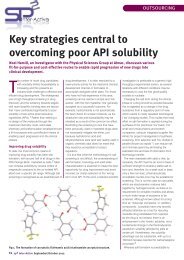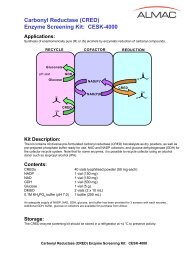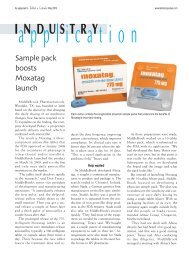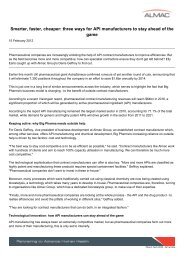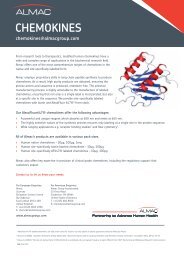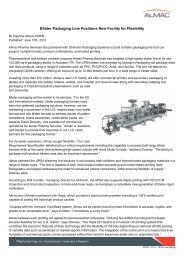Diazocarbonyls Versatile Intermediates in Chemical Synthesis - Almac
Diazocarbonyls Versatile Intermediates in Chemical Synthesis - Almac
Diazocarbonyls Versatile Intermediates in Chemical Synthesis - Almac
- No tags were found...
You also want an ePaper? Increase the reach of your titles
YUMPU automatically turns print PDFs into web optimized ePapers that Google loves.
<strong>Diazocarbonyls</strong><strong>Versatile</strong> <strong>Intermediates</strong> <strong>in</strong> <strong>Chemical</strong> <strong>Synthesis</strong>Michael Anthony McKervey & Hugues Miel<strong>Almac</strong> Sciences Ltd<strong>Almac</strong> House,20 Seagoe Industrial Estate, Craigavon BT63 5QD, UK (www.almacgroup.com)Anne HodgsonPhoenix <strong>Chemical</strong>s Ltd34 Thursby Road, Croft Bus<strong>in</strong>ess Park, Bromborough, Wirral CH62 3PW, UK(www.phoenixchem.com)IntroductionAlthough more than a century has passed s<strong>in</strong>ce the German chemists Curtius and Buchnerbegan their systematic study of the reactions of ethyl diazoacetate with organic substrates,modern organic synthesis cont<strong>in</strong>ues to benefit from the unique versatility of diazocarbonyl<strong>in</strong>termediates <strong>in</strong> a broad range of transformations, <strong>in</strong>clud<strong>in</strong>g alkene and alkynecyclopropanation, homologation of carboxylic acids, aromatic substitution, alkane C-H<strong>in</strong>sertion, cycloaddition, and heterocycle formation (ref 1).<strong>Almac</strong> Sciences and Phoenix <strong>Chemical</strong>s have been <strong>in</strong>volved for several years <strong>in</strong> exploit<strong>in</strong>g thepotential of diazocarbonyls <strong>in</strong> the synthesis of <strong>in</strong>termediates and build<strong>in</strong>g blocks withapplications <strong>in</strong> pharmaceutical products. It is our hope that our experiences, highlighted <strong>in</strong>this article, will provide an attractive start<strong>in</strong>g po<strong>in</strong>t for anyone <strong>in</strong>terested <strong>in</strong> develop<strong>in</strong>g new orimproved routes to bioactive molecules.The diazocarbonyls of particular <strong>in</strong>terest are those with the diazo group located alpha to acarbonyl group <strong>in</strong> a monosubstituted (1) or a disubstituted diazoketone(2) or a diazoester(3).All three types are accessible via diazo transfer methods, the first <strong>in</strong>volv<strong>in</strong>g the use ofdiazomethane and the latter two us<strong>in</strong>g a sulfonyl azide.ROOHROXCH 2N 2RON 2X = Cl, OCORDiazoketone (1)ROR'sulfonyl azidebaseRON 2R'Diazoketone (2)ROOR'sulfonyl azidebaseRN 2OOR'Diazoester (3)1
Most of our exploratory work has been with term<strong>in</strong>al diazoketones (type 1) which are readilyprepared from diazomethane and an activated acyl derivative such as an acid chloride or ananhydride.Although diazomethane is used extensively <strong>in</strong> the discovery laboratory, its toxicity andexplosive nature have, until relatively recently, precluded the scal<strong>in</strong>g up of such work.However, through the use of cont<strong>in</strong>uous process<strong>in</strong>g technology, Phoenix <strong>Chemical</strong>s hasdeveloped novel and patentable processes for produc<strong>in</strong>g and us<strong>in</strong>g high purity diazomethanesafely on a commercial scale that ma<strong>in</strong>ta<strong>in</strong>s the process <strong>in</strong>ventory of diazomethane at verylow levels at all times. The plant, which <strong>in</strong>corporates reliable monitor<strong>in</strong>g, control, and safetysystems, is capable of produc<strong>in</strong>g> 60 metric tonnes of diazomethane per annum. Itsupplements the Company’s pilot facility, the design and operat<strong>in</strong>g details of which have beendescribed elsewhere (ref. 2). The pilot plant is capable of produc<strong>in</strong>g diazomethane on a rangeof scales from a gram to 1 kilogram/day.Diazoketone reactionsSome of the most important applications of diazoketones <strong>in</strong> synthesis are accessed though arange of reactions <strong>in</strong>volv<strong>in</strong>g the loss of nitrogen <strong>in</strong> a controlled manner.These <strong>in</strong>clude :1.Formation of α-halo ketones by reaction with hydrogen halides, ma<strong>in</strong>ly HCl or HBr;2.Cycloaddition to unsaturated substrates, notably alkenes, alkynes and nitriles;3.Arndt-Eistert Homologation of carboxylic acids via Wolff rearrangement;4.X-H Insertion where X = C, O, N and S groups ;5.Oxidation to α-ketoaldehyde <strong>in</strong>termediates suitable for heterocycle formation.<strong>Almac</strong> Sciences and Phoenix have been particularly active <strong>in</strong> apply<strong>in</strong>g some of theseprocesses to diazoketones derived from am<strong>in</strong>o acids and C-term<strong>in</strong>al peptides of the typeshown <strong>in</strong> Table 1.Am<strong>in</strong>o acids and C-term<strong>in</strong>al peptides with suitable N-protection, (most commonly Boc or Cbz),are readily transformed <strong>in</strong>to α-diazoketones via treatment of an acyl chloride or mixedanhydride <strong>in</strong>termediate with diazomethane. With the possible exception of phenylglyc<strong>in</strong>e, thisconversion is usually racemization free.2
Table (1). Some Am<strong>in</strong>o-Acid Derived Diazoketones (R = Cbz or Boc)PhNHRON 2NRON 2N 2ONH 2OOHfrom (S)-phenylalan<strong>in</strong>efrom (S)-prol<strong>in</strong>efrom (S)-glutamic acidPhNHR HNON 2BocNHNNHRN 2NHR OOMeBocNHOPh N 2from-Phe, Ala from (S)-arg<strong>in</strong><strong>in</strong>e from (S)-beta-phenylalan<strong>in</strong>eThe transformation of diazoketone <strong>in</strong>to α-halomethyl ketone is a classic clean reaction<strong>in</strong>volv<strong>in</strong>g slow addition of the hydrogen halide, HCl or HBr, to a solution of the diazo ketoneat roomtemperature: nitrogen evolution occurs over the addition period and the product can be usedas a solution for further reactions or recovered <strong>in</strong> a high state of purity by removal of solvent.α-Fluoromethyl ketones are also accessible <strong>in</strong> this way, though this reaction is much lessdeveloped; the reaction is not generallyapplicable to the formation α-iodomethyl ketones.The reaction of the phenylalan<strong>in</strong>e deriveddiazoketone with hydrogen chloride(Scheme 1) has been used extensively by us to producethe chloromethyl ketone <strong>in</strong> enantiopure form. These products are valuable <strong>in</strong>termediates forthe production of chiral alcohols via reduction which <strong>in</strong> turn provide access to chiral epoxidesvia cyclisation <strong>in</strong> base.Scheme (1). Stereochemically-Def<strong>in</strong>ed Alcohols and Epoxides from Phenylalan<strong>in</strong>e-DerivedDiazoketonePhPG-NHHON 2PG = Boc or CbzPhPG-NHHOClchemoreductionorbioreductionbaseEPOXIDESPhPG-NHPhPG-NHHHHOHorOHHClCl Halomethyl ketones and ketoaldehydes (see below) also provide direct routes to a rangeof heterocycles, <strong>in</strong>clud<strong>in</strong>g imidazoles, thiazoles am<strong>in</strong>othiazoles, imidazopyrid<strong>in</strong>es and variousfused pyrid<strong>in</strong>es. Several examples are shown below <strong>in</strong> Table 2.3
Table 2 : some heteroaromatic r<strong>in</strong>gs accessible from α -haloketones and α-ketoaldehydes.R1R1NR3NNNHNSNSNNNNRRRRRThe Arndt-Eistert synthesis is a well-established method of homologation of a carboxylic acid.It consists of treat<strong>in</strong>g the diazoketone with a silver catalyst <strong>in</strong> the presence of a nucleophilesuch as water, an alcohol or a primary secondary am<strong>in</strong>e. The reaction can also be promotedphotochemically <strong>in</strong> the absence of catalyst. We have found it particularly useful <strong>in</strong> convert<strong>in</strong>gam<strong>in</strong>o acids and C-term<strong>in</strong>al peptides <strong>in</strong>to am<strong>in</strong>o acid homologues, some examples of whichare shown below <strong>in</strong> Table (3).Table (3). Am<strong>in</strong>o Acid Derivatives via Arndt-Eistert HomologationPhNHCbz(Boc)CHN 2PhNHCbz(Boc)CO 2MeOCbzNHCbzNH CHN 2OCbzNHCbzNHCO 2MeOCHN 2NCbzNCbzCO 2MeNCbzONCbzCbzNH NCHN 2H NHBocCbzNHNNHBocCO 2Me4
Among other important uses of diazocarbonyls as build<strong>in</strong>g blocks <strong>in</strong> synthesis is their ability toundergo cycloaddition to unsaturated substrates. Perhaps the best known reaction <strong>in</strong> thiscategory is cyclopropanation of alkenes us<strong>in</strong>g ethyl diazoacetate , for example the formationofadduct (4) from alkene (5) (Table 4).Table (4). Intermolecular and Intramolecular CyclopropanationCO 2EtNPG5+N 2CHCO 2EtRh catalystNPG4Intermolecular and <strong>in</strong>tramolecular versions of this reaction are available <strong>in</strong>clud<strong>in</strong>g the use ofchiral copper and rhodium catalysts capable of produc<strong>in</strong>g chiral cyclopropanecarboxylic acidderivatives with exceptionally high levels of diastereo-and enantioselectivity( ref. 3).Cycloaddition to heteroatomic unsaturated systems, catalysed by copper or rhodium salts, isalso an important route to heterocycles. reaction with nitriles, for example, produc<strong>in</strong>g directaccess to substituted oxazoles.Table (5). Intermolecular Cycloaddition of <strong>Diazocarbonyls</strong> with NitrilesOMeBocRNOCHN 2+CH 3CNRh catalystRNBocNBocNOCHN 2+CNRh catalystBocNONBrOCNBocNCHN 2+BrRh catalystBocNON5
X-H Insertion reactions of diazocarbonyls encompass an enormous range of functional grouptypes, rang<strong>in</strong>g from <strong>in</strong>termolecular and <strong>in</strong>tramolecular C-C bond formation via C-H <strong>in</strong>sertionto <strong>in</strong>sertion <strong>in</strong>to O-H, N-H, S-H, hal-hal and P-H bonds. Some the many ways of <strong>in</strong>troduc<strong>in</strong>g asubstituent alpha to a carbonyl group via a diazocarbonyl methodology are summarised <strong>in</strong> thestarburst Scheme (2) below.Scheme (3). Functionalis<strong>in</strong>g a Ketone at the Position Alpha to the Carbonyl Group viaDiazocarbonyl <strong>Intermediates</strong>(Reactions requir<strong>in</strong>g Metal Catalysis are Designated M)The f<strong>in</strong>al aspect of diazocarbonyl chemistry which we at ALMAC have explored extensively isoxidation lead<strong>in</strong>g to glyoxals (α- ketoaldehydes) <strong>in</strong>termediates with applications <strong>in</strong> synthesis.We have developed procedures for <strong>in</strong> situ oxidation of term<strong>in</strong>al diazoketones to form glyoxalsof the type shown <strong>in</strong> Scheme (4). Such products are very amenable to further elaboration toα,β-unsaturated carbonyl compounds and heterocycle formation via condensation withdifunctional nitrogen nucleophiles, for example 1,2-diam<strong>in</strong>es lead<strong>in</strong>g to dihydropyraz<strong>in</strong>es,pyraz<strong>in</strong>es, qu<strong>in</strong>oxal<strong>in</strong>es, and azaqu<strong>in</strong>oxal<strong>in</strong>es, several examples of which are shown <strong>in</strong>Scheme(4). Five-membered heterocycles such as imidazoles are also accessible throughchoice of nitrogen nucleophile6
Scheme (3).Heterocycles Derived from GlyoxalsORN 2R = Alkyl, aryl. heteroaryl, am<strong>in</strong>o acid, peptideR2R1RNNNNR3ROHOGlyoxal (alpha-keto aldehyde)RNNNNHRNNRNNNRN NNNRNNNNIn summary, we at <strong>Almac</strong> Sciences and Phoenix <strong>Chemical</strong>s have explored the chemistry ofdiazocarbonyls and have demonstrated several useful and efficient applications <strong>in</strong> thesynthesis of a wide variety of heterocycles with potential <strong>in</strong> medic<strong>in</strong>al chemistry.References1.For a comprehensive survey of the many useful reactions of diazocarbonyl compounds, see“Modern Catalytic Methods for Organic <strong>Synthesis</strong> with Diazocarbonyl Compounds. FromCyclopropanes to Ylides”, M P Doyle, M A McKervey, and Tao Ye, John Wiley and Sons, NewYork, 652pp2.Development of a Cont<strong>in</strong>uous Process for the Industrial Generation of Diazomethane, L DProctor and A J Warr, Org Process Res Develop, 2002, 6, 884-8923.For a detailed account of alkene and alkyne cyclopropanation, <strong>in</strong>clud<strong>in</strong>g the use of chiralrhodium and copper catalysts for asymmetric synthesis, see reference 1, chapters 4 and 57





